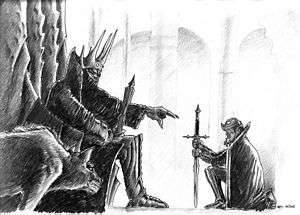Dark Lord
In literature and fiction, Dark Lord is an archetype for a particular form of primary antagonist. The archetype is typical of genre fantasy.[1] Dark lord figures are usually male and are characterized by aspirations to power and identification with a devil or antichrist.[1] The Encyclopedia of Fantasy notes that common themes of dark lord characters include being "already defeated but not destroyed eons before" and engaging in "wounding of the land" or other rituals of desecration.[1]
Alberich, of the Ring cycle of Richard Wagner, is a prototypical dark lord.[1] Other notable dark lord figures include Sauron (of Tolkien's Lord of the Rings) and Morgoth (of Tolkien's The Silmarillion), both of whom were actually referred to as Dark Lords; Arawn Death-Lord of Lloyd Alexander's The Chronicles of Prydain; Darken Rahl of Terry Goodkind's Sword of Truth; Lord Foul in the works of Stephen R. Donaldson; Perimal Darkling of P. C. Hodgell's Chronicles of the Kencyrath; and Ineluki the Storm King of Tad Williams's Memory, Sorrow, and Thorn.[1] Lord Voldemort of Rowling's Harry Potter series is a dark lord archetype.[2] In film, Darth Vader of the Star Wars series is an example of a dark lord figure.[3]
Philip Pullman noted that the dark lord archetype in literature reflects the belief "that evil in the real world is usually embodied in a single person and requires a high position to be effective" and that this contrasts with Hannah Arendt's notion of the banality of evil.[4]
References
- "Dark Lord" in The Encyclopedia of Fantasy (eds. John Clute & John Grant: First St. Martin's Griffin ed.: 1999), p. 250.
- Alice Mills, "Archetypes and the Unconscious in Harry Potter and Diana Wynne Jones's Fire and Hemlock and Dogsbody, in Reading Harry Potter: Critical Essays. Contributions to the Study of Popular Culture, No. 78. Ed. Giselle Liza Anatol (Praeger: 2003), p. 8.
- William Indick, Movies and the Mind: Theories of the Great Psychoanalysts Applied to Film (McFarland, 2004), p. 82.
- David Colbert, The Magical Worlds of Philip Pullman (Penguin, 2006).
